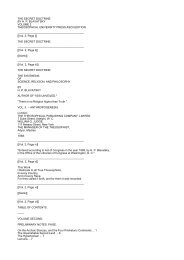You also want an ePaper? Increase the reach of your titles
YUMPU automatically turns print PDFs into web optimized ePapers that Google loves.
Plates V. and VI.<br />
with Horus on <strong>the</strong> day <strong>of</strong> <strong>the</strong> clothing <strong>of</strong> (19) Teshtesh[9] and <strong>of</strong> <strong>the</strong> opening <strong>of</strong> <strong>the</strong> storehouses <strong>of</strong> water<br />
for <strong>the</strong> purification <strong>of</strong> <strong>the</strong> god whose heart moveth not, and (20) <strong>of</strong> <strong>the</strong> unbolting <strong>of</strong> <strong>the</strong> door <strong>of</strong> concealed<br />
things in Re-stau.[10] I am with Horus who (21) guardeth <strong>the</strong> left shoulder <strong>of</strong> Osiris in<br />
[1. The papyrus <strong>of</strong> Ani reads ### as do Pf, Pj, Pk, and Pl. See Naville, Todtenbuch, Bd., I., Bl, p. 2.<br />
2. I.e., Mestha, Hapi, Tuamautef, Qebhsennuf, <strong>the</strong> gods <strong>of</strong> <strong>the</strong> cardinal points.<br />
3. Compare <strong>the</strong> use <strong>of</strong> ### in 2 Samuel, iii. 13.<br />
4. A name <strong>of</strong> <strong>the</strong> temple <strong>of</strong> Ra in Heliopolis. See Brugsch, Dict. Géog., p. 153.<br />
5. I.e., <strong>the</strong> god <strong>of</strong> Tettetu, or Busiris, a town which was believed to contain <strong>the</strong> body <strong>of</strong> Osiris.<br />
6 See Brugsch, Dict. Géog., p. 978.<br />
7. The reading ### . . . . Rextet is given by British Museum papyrus No. 9964. See also Brugsch, Dict. Géog., p. 392.<br />
8. The translation here follows <strong>the</strong> variant reading given by Pierret ### utu en Ra er semaaxeru Ausar. See Aeg.<br />
Zeitschrift, 1869, p. 139; and Le Livre des Morts, p. 10.<br />
9. A name <strong>of</strong> Osiris. See Lanzone, Dizionario, p. 1262.<br />
10. I.e., "<strong>the</strong> door <strong>of</strong> <strong>the</strong> passages <strong>of</strong> <strong>the</strong> tomb." A picture <strong>of</strong> Re-stau ### is given on Plate VIII.]<br />
{p. 272}<br />
Sekhem,[1] and I (22) go into and come out from <strong>the</strong> divine flames[2] on <strong>the</strong> day <strong>of</strong> <strong>the</strong> destruction (23)<br />
<strong>of</strong> <strong>the</strong> fiends in Sekhem. I am with Horus on <strong>the</strong> day <strong>of</strong> <strong>the</strong> (24) festivals <strong>of</strong> Osiris, making <strong>the</strong> <strong>of</strong>ferings<br />
on <strong>the</strong> sixth day <strong>of</strong> <strong>the</strong> festival,[3] [and on] <strong>the</strong> Tenat[4] festival in (25) Annu. I am a priest in Tattu, I<br />
Rere (?) in "<strong>the</strong> temple <strong>of</strong> Osiris,[6] [on <strong>the</strong> day <strong>of</strong>] casting Up (26) <strong>the</strong> earth.[7] I see <strong>the</strong> things which<br />
are concealed in Re-stau. (27) I read from <strong>the</strong> book <strong>of</strong> <strong>the</strong> festival <strong>of</strong> <strong>the</strong> Soul [which is] in Tattu.[8] I am<br />
<strong>the</strong> Sem[9] priest (28), and I perform his course. I am <strong>the</strong> great chief <strong>of</strong> <strong>the</strong> work [10] on <strong>the</strong> day <strong>of</strong> <strong>the</strong><br />
placing <strong>of</strong> <strong>the</strong> hennu<br />
[1. Sekhem is <strong>the</strong> metropolis <strong>of</strong> ### or ### Khens, <strong>the</strong> Greek Letopolites, <strong>the</strong> 2nd nome <strong>of</strong> Lower Egypt; it is <strong>the</strong> ###, or<br />
### <strong>of</strong> <strong>the</strong> Coptic writers, and was situated about twenty-five miles north <strong>of</strong> Memphis. According to a text at Edfu, <strong>the</strong><br />
neck <strong>of</strong> Osiris, ### maxaq, was preserved <strong>the</strong>re. The god Horus, under <strong>the</strong> form <strong>of</strong> a lion, was worshipped at Sekhem. See<br />
Brugsch, Aeg. Zeitschrift, 1879, pp. 33-36; Brugsch, Dict. Géog., p. 738; and De Rougé, Géographie Ancienne, p. 8.<br />
2. The chief variants are ###, (see Naville, Todtenbuch, Bd. II, Bl. 8.) On this passage see Devéria, Aeg. Zeitschriff, 1870,<br />
p. 60.<br />
3. I.e., <strong>the</strong> day <strong>of</strong> <strong>the</strong> festival <strong>of</strong> Osiris who is called "Lord <strong>of</strong> <strong>the</strong> Festival <strong>of</strong> <strong>the</strong> Sixth Day." A list <strong>of</strong> <strong>the</strong> festivals <strong>of</strong> <strong>the</strong><br />
month is given by Brugsch, Matériaux pour servir à la reconstruction du Calendrier; Leipzig, 1864, plate iv.<br />
4. I.e., <strong>the</strong> festival on <strong>the</strong> 7th day <strong>of</strong> <strong>the</strong> month. See Brugsch, op. cit., plate iv.<br />
5. Var. ### Tatau.<br />
6. The reading <strong>of</strong> <strong>the</strong> text is not usual. British Museum papyrus No. 9901 has, after Tattu, ### and according to this text we<br />
should read, "I am a priest in Tattu, exalting him that is upon <strong>the</strong> steps (Pierret, "degrés de l'initiation"); I am a prophet in<br />
Abtu on <strong>the</strong> day <strong>of</strong> casting up <strong>the</strong> earth."<br />
7. According to Devéria (Aeg. Zeitschrift, 1870, p. 61), "casting up <strong>the</strong> earth" means <strong>the</strong> day <strong>of</strong> digging <strong>the</strong> grave.<br />
8 Var. ### "The Ram, lord <strong>of</strong> Tattu," i.e., Osiris.<br />
http://www.sacred-texts.com/egy/ebod/ebod17.htm (9 <strong>of</strong> 12) [8/10/2001 11:26:43 AM]

















